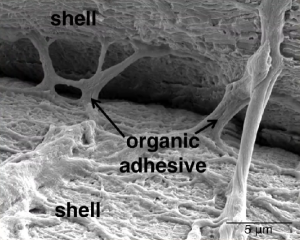73 What Sticky Sea Creatures Can Teach Us About Making Glue
Kinkead Crotts and Rosie Fisher
This TEDxPurdueU talk was recorded at Purdue University in West Lafayette, Indiana in March of 2018. Dr. Wilker discussed his research on the sticking properties of marine animals, such as mussels, oysters and barnacles. These sea creatures have a unique ability to stick underwater. These marine organisms thrive in harsh, turbulent environments by developing natural adhesives that allow them to attach to surfaces and to each other. This adhesion is critical for their survival, offering protection from predators and the elements [1].

The talk highlighted ongoing research into understanding the chemistry and biology behind these natural adhesives. Experiments involve simulating natural conditions to induce the production of adhesives in a controlled environment, then studying the adhesive properties and their molecular structures. Studying these natural marine adhesives allowed them to work to develop new, synthetic alternatives. This is largely because if they were to only derive the adhesives from the sea creatures, it would never be enough for useful applications. These new synthetic adhesives are designed to work under challenging conditions, such as underwater and in the human body, where traditional adhesives fail. In terms of medical applications, the adhesives are being explored since they are non-toxic and strong. This can allow them to replace sutures and screws in surgical procedures, reducing the loss of healthy tissue and bone [1].
Currently, this glue is not available on the market. There is a high barrier to entry, due to the high cost of research. This glue is more environmentally friendly and relatively low in cost since it is derived from corn.

